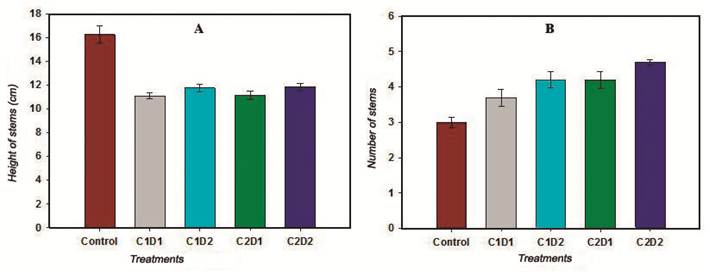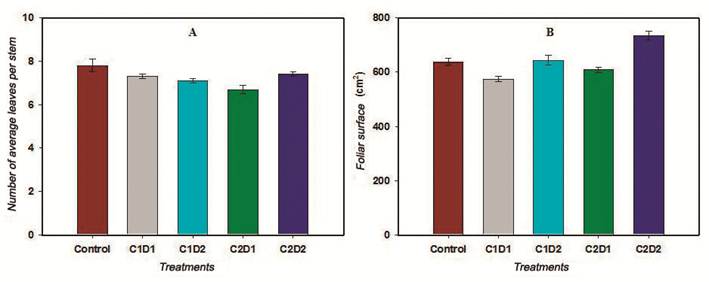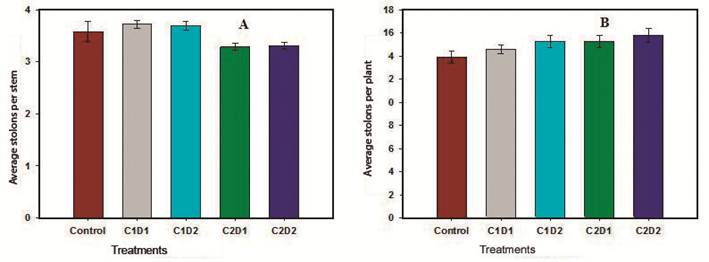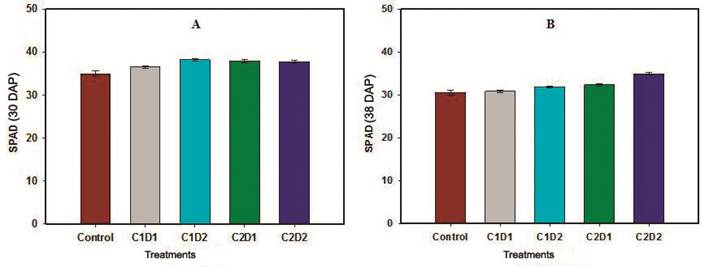Mi SciELO
Servicios Personalizados
Articulo
Indicadores
-
 Citado por SciELO
Citado por SciELO
Links relacionados
-
 Similares en
SciELO
Similares en
SciELO
Compartir
Cultivos Tropicales
versión On-line ISSN 1819-4087
cultrop vol.40 no.2 La Habana abr.-jun. 2019 Epub 01-Jun-2019
Original Article
Selection of a promoting rhizobacteria of growth in papa (Solanum tuberosum L.)
1Instituto Nacional de Ciencias Agrícolas (INCA), carretera San José-Tapaste, km 3½, Gaveta Postal 1, San José de las Lajas, Mayabeque, Cuba. CP 32 700
The use of plant growth promoting rhizobacteria has beneficial effects on crops, so the objective of this work was to select a strain of Rhizobium genus able to stimulate growth in potatoes. To this end, work was carried out under semicontrolled conditions and the use of two strains (C1: Rhizobium etli CE-3 and C2: Bradyrhizobium elkani ICA 8001) as well as two doses of each (D1: 3 μL and D2: 6 μL) applied in the niche in which the tuber was placed at the time of planting. Through a completely randomized design, five treatments were distributed, including the control not inoculated and the use of strains and doses, with ten repetitions for each one. In any case no chemical fertilization was applied. Containers of six-liter capacity filled with red Ferralitic Eutric soil were used. The evaluations were made at 40 days after plantation and consisted in determining the height of the plants, the number of stems, the number of stolons emitted by tubers, the average number of leaves per stem, the leaf surface and the SPAD units determined in two moments. In all the evaluated variables, the strain Bradyrhizobium elkani ICA 8001, was the one that favored the best result with significant differences respect to the control.
Key words: Rhizobium; height of the plant; number of stems; leaf area; stolons
INTRODUCTION
The depletion of natural resources by the action of man in an excessive way, urges the use of new technologies to minimize the deterioration caused to the environment, hence, today, it is that they are largely friendly to the environment, in the control of pests and crop diseases and of the agro-ecosystems, in order to restore and maintain soil fertility.
Among these practices, the use of organic fertilizers and native microorganisms as group promoting rhizobacteria Plant Growth (PGPR, for its acronomyns) could be part of the effective solution in reducing the use of agrochemicals and fertility recovery of agricultural soils 1.
PGPRs are soil microorganisms, usually bacteria and fungi, that are naturally associated with plant roots in a more or less intimate way; they directly or indirectly facilitate the availability of certain nutrients for plants, such as nitrogen, phosphorus and iron 2, but not all contribute in the same way, their action has been proven in different crops 3 such as: wheat 4, corn 5 and beans 6, among others. These studies show the ability of the PGPR to increase growth and yield them, with less use of products agrochemicals, which avoids damages to the environment 3.
Potato cultivation (Solanum tuberosum L.) has been developed and widely studied throughout the world, being considered one of the main foods for humans worldwide, surpassed only by rice, wheat and corn 7.
The same authors consider that potato productions are high, but to achieve them it is necessary to use different products, usually of a chemical nature (fertilizers, pesticides, etc.), both to ensure adequate plant nutrition, and to control pests that reduce yields. It is also essential to promote adequate growth and development of plants, even when both are determined by genetic and environmental factors 8 and are the result of the interaction between photosynthesis, respiration, transport of assimilates, water relations and mineral nutrition; which translates to the irreversible increase in dry matter, volume, length or area, as result of division, expansion and differentiation 9.
From the foregoing, the objective of the present work was to select a strain of the genus Rhizobium that stimulates the growth of potato plants.
MATERIALS AND METHODS
The work was carried out in semi-controlled conditions at the National Institute of Agricultural Sciences (INCA), for which, in the first half of December, seed tubers obtained in the Romano variety country were planted, with a size of 35-45 mm.
A completely randomized design was used made, in which distributed the five treatments considered, they consisted of: one uninoculated control and inoculum with the use of two strains: C1 ( Rhizobium etli EC-3) and C2: (Bradyrhizobium elkani ICA 8001) as well as two doses of each (D1: 3 µL and D2: 6 µL) which were determined from the mass of the seed tubers that were used in the planting, these were applied in the niche in which the tuber was placed at the time of planting. Each treatment featured 10 repetitions.
The containers, with a volume of 6 L, were filled with Eutric Red Ferralitic soil 10 and no fertilization of any kind was used. Soil moisture was maintained at maximum retention capacity by adding water lost by evapotranspiration, manually.
The evaluations made at 40 days after planting (DAP) consisted of analyzing the 10 plants of each of the treatments, to know the height of the plants (cm), the number of stems per plant, the amount of stolons that they had tubers per stem, the average number of leaves per stem, the leaf area in cm2 from the linear measurements (length and width) of the leaves of each stem and the use of the formula previously established by regression analysis for this variety (y=LxA(0.495)+5.281) where L represents the length of the leaf and A its width and finally, it was estimated in two moments of plant growth (31 and 38 DAP) the level of leaf chlorophyll in leaves, expressed in SPAD units, by using a portable meter (MINOLTA).
The data obtained were grafficated with the use of the SIGMA PLOT v.11 program and after knowing the confidence interval of the means the treatments were compared by t-Student at 1-α ≤0.05, with the use of the STATGRAPHYCS program S v.5.0.
RESULTS AND DISCUSSION
The height of the plant and the average number of stems per plant (A and B), respectively, is presented in Figure 1. For treatments were inoculated with strains and doses, values were minors without significant differences between them, although with respect to the control, where the plants reached a greater height with significant differences compared to the rest of the treatments.
 The bar above means the confidence interval of the means at 1-α≤0.05
The bar above means the confidence interval of the means at 1-α≤0.05Figure 1 Plant height A (in cm) and average number of stems per plant (B) in potato plants inoculated with two strains of rhizobia (C1: Rhizobium etli CE-3 and C2: Bradyrhizobium elkani ICA 8001) and two doses of each (D1: 3 µL and D2: 6 µL )
In the case of the number of stems per plant these were significantly lower in the control, with respect to the inoculated plants. The higher dose (6 µL) increased the number of stems in both strains, with significant differences from the lowest dose in each; but strain 2, which corresponds to Bradyrhizobium elkani ICA 8001, gave the best result, only comparable with strain 1 (Rhizobium etli CE-3) when the highest dose was used.
According to the results, it is observed that there may be a close relationship between the height of the plants and the number of stems, because increasing these in the plant reduces the height, which among other factors, is related to the possibilities that It has the seed tuber to provide the new plant with its reserves, having to share them with a smaller amount of stems, these will be favored in their growth 11.
As for the height, it has been suggested that it depends largely on the density of stems, if it is low, then the plants reach a greater height 11 and vice versa. The effect of the use of growth-promoting microorganisms also plays an important role in this variable, as was the case with this work, since its beneficial effect has been proven in this regard, as well as in a work carried out in potatoes, but in the production of mini-tubers, the authors verified that the inoculation performed in vitro plants of potato cv. 'Romano' strains of bacteria, but the genus Bacillus, had positive influence on plant height and number of stems, while noting that this also depends on the strain used 12. On the other hand, other authors pointed out that at least no product that stimulates sprouting is used 13, no increase in the number of stems per plant will be found, although the varietal difference 14 should not be ruled out. The management of the number of stems 15 will also have a marked influence on the size distribution of the tubers.
The average number of leaves per stem (A) and leaf area (B) occurs in Figure 2. While differences in the average number of leaves per stem not manifest between treatments except treatment in the strain 2 was applied, with the lowest dose, then this variable determinant in many cases the value of the leaf surface, wherein if differences between treatments were found the behavior of the latter, in terms of the magnitude achieved was the result of the average number of stems per plant, since there were differences in that variable, as already analyzed.
L to leaf area was greater in the treatment the plants were inoculated with the strain Bradyrhizobium elkani ICA 8001, when the highest dose was applied (C2D2), with significant differences with the other treatments. Between the control treatment and the rest of the treatments, there were no significant differences, except with the treatment in which the lowest dose of the strain Rhizobium etli CE-3 was applied. It means that in the treatments inoculated with any of the strains used at the highest dose applied (6 µL) there were always significant differences in relation to the lower dose, which indicates that this is more suitable to be used in the culture that It has been studied.
The leaf surface is one of the important variables related to the studies of plant growth, since its magnitude is associated with the ability of the plant to perform the photosynthetic process, since there is a direct relationship in this regard. In works carried out where the effect of inoculation on plant growth has been evaluated, an increase in leaf surface values has been found for the specific case of the potato 16, with respect to the control, although the strain of Rhizobium used it was not the same.
 The bar above means the confidence interval of the means at 1-α≤0.05
The bar above means the confidence interval of the means at 1-α≤0.05Figure 2 Average number of leaves per stem (A) and leaf area per plant (B) in potato plants inoculated with two strains of rhizobia (C1: Rhizobium etli CE-3 and C2: Bradyrhizobium the Kani ICA 8001) and two doses of each (D1: 3 µL and D2: 6 µL )
The leaf surface is one of the important variables related to the growth of plants, since its magnitude is associated with the ability of the plant to carry out the photosynthetic process, since there is a direct relationship in this regard. In works carried out where the effect of inoculation on plant growth has been evaluated, an increase in leaf surface values has been found for the specific case of the potato 16, with respect to the control, although the strain of Rhizobium used it not was the same.
The evaluations of SPAD units at 30 (A) and 38 (B) DAP, are presented in Figure 3. The tendency in general was to find higher values with respect to the control in the plants that were inoculated, with significant differences regarding this treatment, except in the evaluation carried out at 38 days, where there were no significant differences between the control and the strain Rhizobium etli CE-3.
The values were lower at 38 days, perhaps because the nutritional deficiency became more evident when the plants reached a greater development and need for nutrients that had not been satisfied when fertilizer contributions were not made in the plantation, therefore, the supply to the plants for their nutritional needs they only depended on the contributions that the soil could make and on the beneficial effects that the growth promoting bacteria inoculated at the time of establishing the plantation. In this sense, strain 2 stands out, where the values were in eight higher units.
Higher values of SPAD units are related to higher chlorophyll contents, which ensures a greater capacity for carrying out the photosynthetic process, in turn, a better nutritional status of the plants 17.
 The bar above means the confidence interval of the means at 1-α ≤0.05
The bar above means the confidence interval of the means at 1-α ≤0.05Figure 3 Units SPAD certain 30 (A) and 38 (B) DAP, in potato plants inoculated with two strains of rhizobio (C1: Rhizobium etli CE-3 and C2: Bradyrhizobium eIkani ICA 8001) and two doses of each (D1: 3 µL and D2: 6 µL)
The presence of growth promoting bacteria by inoculation with strains of the genus Rhizobium, contributed to improve the nutritional status, which is related to a work in which to examine the rhizosphere of potato plants subjected to nutritional deficiency an increase in the number of Rhizobium species was found, which improved the nutritional status of the plants 18, so it will be necessary to evaluate other strains of that genus.
On the other hand, it is noted that high doses of nitrogen 19 are used in potato cultivation in order to increase yields, which show a low rate of use of this nutrient and high nitrate content in the lower soil layers. It has also been found that traditional production systems, which are used amounts Elevate to s agrochemicals are causing damages in potato production 20. Perhaps, as several authors point out 21-23, the most convenient would be a mixture of both chemical and organic, thus reducing the former and contributing to the care of the environment. Appearance is that it has been stressed recently 24.
When the end of the crop cycle was not reached, it was considered important to analyze the number of stolons that had already formed a tuber at the time of the evaluation , as an important part in the production of this crop , these results are presented in Figure 4.
As can be seen in the figure, the average number of stolons per stem (A) did not show differences between treatments, which are evidenced in the average per plant (B), all of which is closely related to the number of stems, aspect Already analyzed.
It is noted that the highest average stolons per plant, with significant differences from the control, was achieved with strain 2 and any of the doses used, similarly occurred with strain 1, but when the highest dose was used. Between the control and that strain at the lowest dose, no significant differences were detected. In this way, it can be ensured that the number of tubers produced per plant will be greater in the treatments that were inoculated. Increases in the number of average stolons per plant in plants that were inoculated with the highest dose, meant 10.1% in strain 1 and 13.7% in strain 2.
 The bar above means the confidence interval of the means at 1-α≤0.05
The bar above means the confidence interval of the means at 1-α≤0.05Figure 4 Assessment number stolons average per stem (A) and average per plant (B) at 38 DAP , in poato plants inoculated with two strains of rhizobio (C1: Rhizobium etli CE-3 and C2: Bradyrhizobiume elkani ICA 8001) and two doses of each one (D1: 3 µL and D2: 6 µL)
The tuberization process occurs during the vegetative period, in that period, under the soil surface, the stolon tips begin to widen, giving way to the formation of the tubers. This phenomenon occurs approximately 30 days after the emergence in early varieties, between 35 and 45 days for intermediate varieties, and between 50 and 60 days in those of late type 25. Despite the prevailing climatic conditions in Cuba, the varieties used are mostly early, such is the case of the Romano variety used in this study 26.
Phytohormones, besides the photoperiod and temperature, play a major role, as they regulate the morphological events tuberization activated at the apex of a stolon; high levels of gibberellins inhibit tuberization, while low levels promote it. Transcription factors are proteins that bind to DNA to regulate gene activity and in some cases, to regulate hormone levels; several of these protein DNA ligatures are involved in the regulation of plant growth and the development of potato meristems, including tuber formation 27.
The production of phytohormones by bacteria and their impact on root morphogenesis could largely explain the positive effects of diazotrophic bacteria on plant growth, as the number of radical hairs and lateral roots increases 28 but, at least in the literature consulted, nothing is indicated regarding the stimulation of tuberization , however, the beneficial effects that contribute to growth in general, also favor the development of other processes, even when they are not fully involved in them.
CONCLUSIONS AND RECOMMENDATIONS
The results allowed us to verify that the use of the strain Bradyrhizobium elkani ICA 8001, with a dose of 6 µL per tuber, increased the number of stems per plant, the leaf surface and the number of stolons, given by the positive effect that it causes in the growth of different species. However, other strains of the same genus or another could be tested , which will also contribute to deepening aspects related to plant nutrition and the possible decrease in chemical fertilization, with the consequent decrease in environmental pollution, aspect Of great interest today.
BIBLIOGRAFÍA
1. Arcos J, Zúñiga D. Rizobacterias promotoras de crecimiento de plantas con capacidad para mejorar la productividad en papa. Revista Latinoamericana de la Papa. 2016;20(1):18-31. [ Links ]
2. Naqqash T, Hameed S, Imran A, Hanif MK, Majeed A, van Elsas JD. Differential response of potato toward inoculation with taxonomically diverse plant growth promoting rhizobacteria. Frontiers in Plant Science. 2016;7(144):1-12. doi:10.3389/fpls.2016.00144 [ Links ]
3. Tailor AJ, Joshi BH. Harnessing plant growth promoting rhizobacteria beyond nature: a review. Journal of Plant Nutrition. 2014;37(9):1534-71. doi:10.1080/01904167.2014.911319 [ Links ]
4. Majeed A, Abbasi MK, Hameed S, Imran A, Rahim N. Isolation and characterization of plant growth-promoting Rhizobacteria from wheat rhizosphere and their effect on plant growth promotion. Frontiers in Microbiology. 2015;6(198):1-10. doi:10.3389/fmicb.2015.00198 [ Links ]
5. Qaisrani MM, Mirza MS, Zaheer A, Malik KA. Isolation and identification by 16S rRNA sequence analysis of Achromobacter, Azospirillum and Rhodococcus strains from the Rhizosphere of maize and screening for the beneficial effect on plant growth. Pakistan Journal of Agricultural Sciences (Pakistan). 2014;51(1):91-9. [ Links ]
6. Pérez-Montaño F, Alías-Villegas C, Bellogín RA, del Cerro P, Espuny MR, Jiménez-Guerrero I, et al. Plant growth promotion in cereal and leguminous agricultural important plants: From microorganism capacities to crop production. Microbiological Research. 2014;169(5-6):325-36. doi:10.1016/j.micres.2013.09.011 [ Links ]
7. Devaux A, Kromann P, Ortiz O. Potatoes for sustainable global food security. Potato Research. 2014;57(3):185-99. doi:10.1007/s11540-014-9265-1 [ Links ]
8. Tekalign T, Hammes PS. Growth and productivity of potato as influenced by cultivar and reproductive growth: II. Growth analysis, tuber yield and quality. Scientia Horticulturae. 2005;105(1):29-44. doi:10.1016/j.scienta.2005.01.021 [ Links ]
9. Franke AC, Haverkort AJ, Steyn JM. Climate change and potato production in contrasting south african agro-ecosystems 2. assessing risks and opportunities of adaptation strategies. Potato Research. 2013;56(1):51-66. doi:10.1007/s11540-013-9229-x [ Links ]
10. Hernández Jiménez A, Pérez J, Bosch D, Castro N. Clasificación de los suelos de Cuba. Mayabeque, Cuba: Ediciones INCA; 2015. 93 p. [ Links ]
11. de Almeida FM, Arzuaga Sánchez J, Torres de la Noval W, Cabrera Rodríguez JA. Efectos de diferentes distancias de plantación y calibres de tubérculos-semilla sobre algunas características morfo-productivas de la papa en Huambo, Angola. Cultivos Tropicales. 2016;37(2):88-95. [ Links ]
12. Alvarado-Capó Y, Martín MC, Mena E, Suárez MA, Roque B, Pichardo T, et al. Efecto de Bacillus spp. sobre el crecimiento y rendimiento agrícola de plantas in vitro de papa cv. Romano'en casa de cultivo. Biotecnología Vegetal. 2015;15(2):115-22. [ Links ]
13. Rojas Mercado LP, Seminario Cunya JF. Productividad de diez cultivares promisorios de papa chaucha (Solanum tuberosum, grupo Phureja) de la región Cajamarca. Scientia Agropecuaria. 2014;5(4):165-75. [ Links ]
14. Medina EL, Salvatierra CZ, Benavides MG, Rodríguez RS, Torres JC. Rendimiento comparativo de cuatro variedades nuevas de Solanum tuberosum L. "papa" en el anexo Chaquicocha, distrito Tayabamba, Pataz, La Libertad. ARNALDOA. 2015;20(1):155-170-170. doi:10.22497/142 [ Links ]
15. Knowles LO, Knowles NR. Optimizing tuber set and size distribution for potato seed (Solanum tuberosum L.) expressing varying degrees of apical dominance. Journal of Plant Growth Regulation. 2016;35(2):574-85. doi:10.1007/s00344-015-9562-1 [ Links ]
16. Diestra Guevara E. Efecto de la coinoculación de Rhizobium etli y Azotobacter chroococcum sobre el crecimiento de Solanum tuberosum "papa" variedad Canchán en condiciones de laboratorio. [Internet] [Tesis de Diploma]. [Trujillo, Perú]: Universidad Nacional de Trujillo; 2014. 59 p. Available from: http://dspace.unitru.edu.pe/bitstream/handle/UNITRU/4049/Diestra%20Guevara%20Eder%20Armando.pdf?sequence=1&isAllowed=y16. [ Links ]
17. Gil PT de, Fontes PCR, Cecon PR, Ferreira FA. Índice SPAD para o diagnóstico do estado de nitrogênio e para o prognóstico da produtividade da batata. Horticultura Brasileira. 2002;20(4):611-5. doi:10.1590/S0102-05362002000400020 [ Links ]
18. Unno Y, Shinano T, Minamisawa K, Ikeda S. Bacterial community shifts associated with high abundance of Rhizobium spp. in potato roots under macronutrient-deficient conditions. Soil Biology and Biochemistry. 2015;80:232-6. doi:10.1016/j.soilbio.2014.10.002 [ Links ]
19. Marouani A, Harbeoui Y. Eficiencia de uso de nitrógeno en el cultivo de papa (Solanum tuberosum L.). Acta Agronómica. 2016;65(2):164-9. doi:10.15446/acag.v65n2.48200 [ Links ]
20. Tein B, Kauer K, Eremeev V, Luik A, Selge A, Loit E. Farming systems affect potato (Solanum tuberosum L.) tuber and soil quality. Field Crops Research. 2014;156:1-11. doi:10.1016/j.fcr.2013.10.012 [ Links ]
21. Luna Murillo R, Espinosa Cunuhay K, Trávez Trávez R, Ulloa Méndez C, Espinoza Coronel A, Bejarano Albornoz A. Respuesta de variedades de papa (Solanum tuberosum L.) a la aplicación de abonos orgánicos y fertilización química. Ciencia y Tecnología (Quevedo). 2016;9(1):11-6. [ Links ]
22. Abreu Cruz EO, González Oramas G, Liriano González R, Veliz Alonso JI, Ost P, Monzón Cepero Z. Respuesta del cultivo de papa (Solanum tuberosum L.) a la combinación delfertilizante ecológico HerbaGreen con fertilizante químico. Centro Agrícola. 2017;44(1):80-9. [ Links ]
23. Marín S, Bertsch F, Castro L. Efecto del manejo orgánico y convencional sobre propiedades bioquímicas de un andisol y el cultivo de papa en invernadero. Agronomía Costarricense [Internet]. 2017 [cited 2019 May 23]; doi:10.15517/rac.v41i2.31298 [ Links ]
24. Reganold JP, Wachter JM. Organic agriculture in the twenty-first century. Nature Plants. 2016;2(2):15221. doi:10.1038/nplants.2015.221 [ Links ]
25. Acuña I, Muñoz M, Sandaña P, Orena S, Bravo R, Kalazich J, et al. Manual Interactivo de la Papa INIA [Internet]. Chile: Instituto de Investigaciones Agropecuarias (INIA); 2015 [cited 2019 Jun 25]. Available from: http://manualinia.papachile.cl25. [ Links ]
26. Martín Martín R, Jerez Mompie E. Efecto de las temperaturas en el rendimiento de la papa (Solanum tuberosum L.) variedad Romano. Cultivos Tropicales. 2017;38(1):75-80. [ Links ]
27. Hannapel DJ, Chen H, Rosin FM, Banerjee AK, Davies PJ. Molecular controls of tuberization. American Journal of Potato Research. 2004;81(4):263-74. doi:10.1007/BF02871768 [ Links ]
28. Hernández-Rodríguez A, Rives-Rodríguez N, Acebo-Guerrero Y, Diaz-de la Osa A, Heydrich-Pérez M, Divan Baldani VL. Potencialidades de las bacterias diazotróficas asociativas en la promoción del crecimiento vegetal y el control de Pyricularia oryzae (Sacc.) en el cultivo del arroz (Oryza sativa L.). Revista de Protección Vegetal. 2014;29(1):1-10. [ Links ]
Received: October 01, 2018; Accepted: March 28, 2019











 texto en
texto en 


